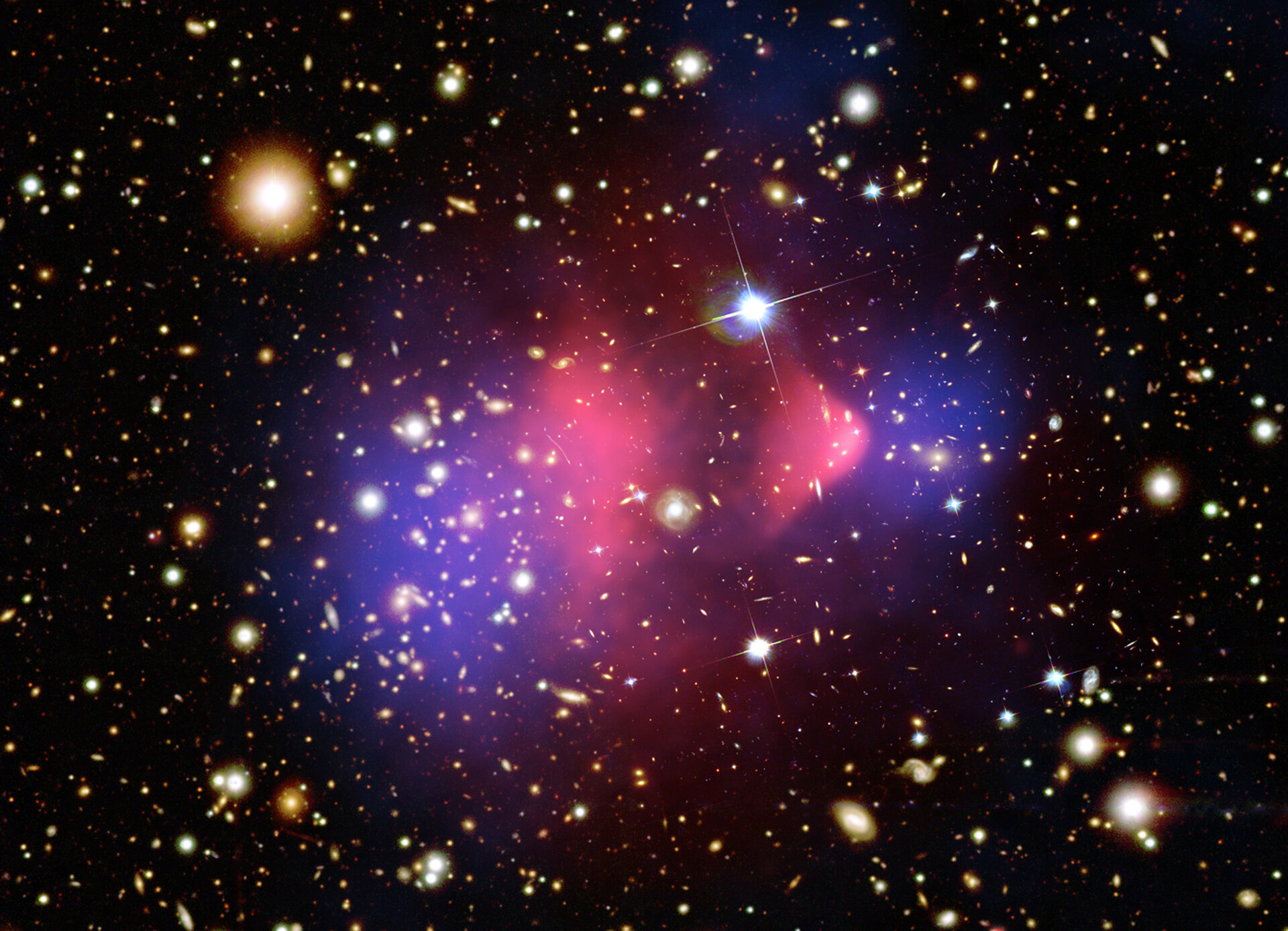What is Dark Matter?
Evidence for Missing Matter
The Standard Model of particle physics provides a remarkably accurate description of the matter in our Universe and the forces governing it, but it is clear that the theory falls short and cannot explain several observed phenomena. There is an abundance of evidence to suggest that the majority of matter in the Universe is non-baryonic, non-luminous, "dark" matter. Its presence has only been inferred through its gravitational interactions with Standard Model matter; any other interactions must be incredibly weak.
Some of the earliest evidence for dark matter comes from observations of rotational velocities of galaxies. In the 1930s, Zwicky made measurements of rotational velocities for galaxies in the Coma cluster. The rotational velocities were significantly higher than expected based on the mass distribution of the cluster determined from luminous matter. This discrepancy and apparent 'missing mass' baffled the scientific community. In the 1960s Rubin and Ford used measurements of rotational velocities of objects in galaxies to infer the existence of large clouds of non-luminous matter around galaxies, referred to as a dark matter halo.
 ESA and NASAPerhaps the most visually striking evidence for dark matter is the so-called Bullet Cluster, which is actually composed of two colliding clusters. Individual objects such as stars passed one another without collisions, but X-ray measurements indicate that the gaseous components of each cluster were slowed by the collision. The mass distribution of the luminous components of the two clusters is dominated by the gaseous components, and can be inferred from these measurements (shown on the left in red). The mass distribution can also be measured through gravitational lensing, the bending of light around a massive body. These measurements paint a different picture (shown in blue): the centres of mass inferred from gravitational lensing are offset from the centres of mass of the luminous matter. What can this mean? The dark matter interpretation suggests that the mass of each cluster is predominantly in the form of nonluminous matter that is collisionless - it interacts (at most) weakly with the surrounding matter and itself.
ESA and NASAPerhaps the most visually striking evidence for dark matter is the so-called Bullet Cluster, which is actually composed of two colliding clusters. Individual objects such as stars passed one another without collisions, but X-ray measurements indicate that the gaseous components of each cluster were slowed by the collision. The mass distribution of the luminous components of the two clusters is dominated by the gaseous components, and can be inferred from these measurements (shown on the left in red). The mass distribution can also be measured through gravitational lensing, the bending of light around a massive body. These measurements paint a different picture (shown in blue): the centres of mass inferred from gravitational lensing are offset from the centres of mass of the luminous matter. What can this mean? The dark matter interpretation suggests that the mass of each cluster is predominantly in the form of nonluminous matter that is collisionless - it interacts (at most) weakly with the surrounding matter and itself.
 ESA and the Planck CollaborationWe can also make measurements on the cosmological scale, probing deeper into the nature of the Universe. The Planck satellite has measured the cosmic microwave background (CMB): radiation left over from an early epoch of the Universe that has been free streaming ever since. The CMB has a very uniform temperature of 2.7K, but has anisotropies which can be measured, as shown in the image on the right. Modelling these anisotropies with a well motivated model which includes cold dark matter indicates that roughly 85% of matter is nonluminous and nonbaryonic dark matter.
ESA and the Planck CollaborationWe can also make measurements on the cosmological scale, probing deeper into the nature of the Universe. The Planck satellite has measured the cosmic microwave background (CMB): radiation left over from an early epoch of the Universe that has been free streaming ever since. The CMB has a very uniform temperature of 2.7K, but has anisotropies which can be measured, as shown in the image on the right. Modelling these anisotropies with a well motivated model which includes cold dark matter indicates that roughly 85% of matter is nonluminous and nonbaryonic dark matter.
Weakly Interacting Massive Particles
One favoured candidate for dark matter is the weakly interacting massive particle (WIMP). WIMPs are hypothesized to have been produced thermally in the early Universe and also annihilate to Standard Model particles. The strength of this process sets the current dark matter abundance, and can naturally lead to the correct dark matter abundance in the present.
Despite the weak scale of dark matter interactions, the local galactic dark matter density is high enough that we should be able to search for interactions of dark matter with regular matter. Direct detection experiments have largely focused on searching for WIMPs, which have an expected mass range of ~1 GeV/c2 to ~100 TeV/c2. Despite vast experimental efforts, no discovery of the WIMP has been made, though much of the possible parameter space has been excluded.
The Push to Low Mass
With the lack of discovery of the WIMP, significant interest has been garnered in low mass dark matter candidates, including light dark matter (LDM). Different models are required to search for dark matter candidates with masses below 2 GeV/c2 (below which the abundance of WIMP dark matter would be too high), and new experimental techniques are required to be sensitive to lower masses.
Interactions of LDM with regular matter result in lower energy depositions than those produced by heavier dark matter, and current direct detection experiments typically use heavy targets such as xenon that are better optimized for interactions with standard WIMP masses. A compelling search for light dark matter will involve a light target to optimize the energy transfer for interactions of LDM with regular matter, as well as low energy thresholds.
